
Concept explainers
(a)
Interpretation:
The aqueous solution of
Concept introduction:
Bronsted-Lowry theory: It is based on an acid–base reaction, in this when acid react with base each other, by exchanging of protons the acid forms conjugate base and the base forms as conjugate acid.
Definition of acid and base: If a substance dissociates in water it gives H+ ions (hydrogen ions) is called acid and in the case of base it gives OH- ions (hydroxide ions).
Acidic solution: All cations with the conjugate acids of weak bases is called acidic aqueous solution. When the metal cations have more positive charge then it acts as Lewis acid in aqueous solution.
Neutral solution: If the metal cations are very large or it have very low positive charge then it is considered as neutral cations. In the case of strong acids, the anions are considered as neutral in water.
Basic solution: All anions with the conjugate bases of weak acids is called basic aqueous solution.
(b)
Interpretation:
The aqueous solution of
Concept introduction:
Refer to part (a).
(c)
Interpretation:
The aqueous solution of
Concept introduction:
Refer to part (a).
Want to see the full answer?
Check out a sample textbook solution
Chapter 6 Solutions
Chemical Principles: The Quest for Insight
- Write the amididation reaction mechanism of a-aminophenol and acetic acid to produce acetaminophenarrow_forwardFor the condensation reaction between Alamine and histamine, please help me write the amididation reaction mechanism. Then write the three letter code for the product of the reaction, then write the one letter code for the product of the reaction. arrow_forwardHow to draw the reaction mechasnism belowarrow_forward
- Name the following molecules with IUpacarrow_forwardWhat is the molecular orbital for cyclopropenyl anion and is it aromatic, antiaromatic or nonaromatic?arrow_forwardUsing the chart describe the change from cystine to tyrosine and its impact on the protein. Using the chart describe the change from histidine to aspartic acid and its impact on the protein.arrow_forward
- How to get the predicted product of this reaction belowarrow_forwardPlease help me fill out the chart then using the chart describe the change from cystine to tyrosine and its impact on the protein. Then using the chart describe the change from histidine to aspartic acid.arrow_forwardWrite the Esterification reaction mechanism for acetic acid, and one propanol to make propanol ethanoate (molecule that gives peas its odor in flavor)arrow_forward
 Chemistry: The Molecular ScienceChemistryISBN:9781285199047Author:John W. Moore, Conrad L. StanitskiPublisher:Cengage Learning
Chemistry: The Molecular ScienceChemistryISBN:9781285199047Author:John W. Moore, Conrad L. StanitskiPublisher:Cengage Learning Chemistry & Chemical ReactivityChemistryISBN:9781337399074Author:John C. Kotz, Paul M. Treichel, John Townsend, David TreichelPublisher:Cengage Learning
Chemistry & Chemical ReactivityChemistryISBN:9781337399074Author:John C. Kotz, Paul M. Treichel, John Townsend, David TreichelPublisher:Cengage Learning Chemistry & Chemical ReactivityChemistryISBN:9781133949640Author:John C. Kotz, Paul M. Treichel, John Townsend, David TreichelPublisher:Cengage Learning
Chemistry & Chemical ReactivityChemistryISBN:9781133949640Author:John C. Kotz, Paul M. Treichel, John Townsend, David TreichelPublisher:Cengage Learning Principles of Modern ChemistryChemistryISBN:9781305079113Author:David W. Oxtoby, H. Pat Gillis, Laurie J. ButlerPublisher:Cengage Learning
Principles of Modern ChemistryChemistryISBN:9781305079113Author:David W. Oxtoby, H. Pat Gillis, Laurie J. ButlerPublisher:Cengage Learning



